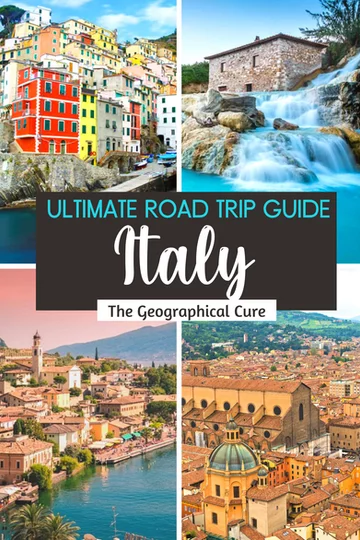It’s only a 6 hour drive from Milan to Rome. But this well-traveled route is dense with amazing must see medieval villages, ornate palazzos, Roman ruins, and sublime treasures of the Renaissance.
There’s plenty of great destinations in Italy to explore along the way. This super detailed 10 day itinerary takes you to them.
It’s perfectly adjustable. You can make it shorter or longer, depending on your available vacation time or personal fast/slow pace.
I’ve tried to give you a balance of cities and leisurely villages, with day trip options as well.
You start with Italy’s exciting northern capital of Milan and end in Italy’s ancient southern capital of Rome.
Along the way, you’ll visit some of Italy’s most beautiful towns in northern Italy, Cinque Terre, and Tuscany.
You may have a near overdose art high on this trip — with ancient Roman ruins, iconic masterpieces, and world class museums at every turn.
This itinerary takes you to all of the must visit sites, historic landmarks, and must visit museums. It tells you everything you need to see, do, and eat on this 10 day road trip from Milan to Rome.
Overview of 10 Days in Italy Itinerary
Here’s what I recommend for a ten day road trip from Milan to Rome:
- Day 1: Explore Milan
- Day 2: Pick up car, stop in Parma, overnight in Bologna
- Day 3: Explore Bologna
- Day 4: Drive To Lucca and explore, overnight in Lucca
- Day 5: Day Trip To Cinque Terre or Pisa from Lucca
- Day 6: Drive To Florence and explore
- Day 7: Explore Florence
- Day 8: Drive To Siena and explore, overnight in Rome
- Day 9: Explore Rome
- Day 10: Explore Rome
In this 10 day Milan to Rome travel itinerary, you’ll have three bases: Milan (1 night), Bologna (2 nights), Lucca (2 nights), Florence (2 nights), and Rome (3 nights).
I give you tips on where to stay for each base.
10 Day Italy Itinerary: Milan To Rome
Here’s the best 10 day itinerary for road tripping from Milan to Rome.
Day 1: Explore Milan
Milan is an amazing destination in northern Italy.
It’s a sleek and chic modern city, the thriving finance and fashion capital of Italy. Milan has a serious arts scene, breathtaking sites, and gastronomical delights.
Milan is not “an industrial city,” as the uninitiated claim. Milan has personality, combining old world charm and “bright lights, big city” flair in compelling fashion. You can’t help but be dazzled by Milan’s architecture, historic sites, iconic art, and fantastic foodie scene.
You might be surprised to know that Milan has some of the greatest artistic treasures of the Renaissance. Milan’s defining artistic moment was the arrival of Leonardo da Vinci in 1481.
Hired by the Duke of Milan as a court artist, Leonardo produced some of his most important works in Milan, including his iconic The Last Supper. The fresco is Milan’s top attraction and one of Europe’s most sought after sites.
Here’s my a complete guide to Leonardo’s The Last Supper and how to see this Renaissance masterpiece. Click here for a ticket and guided tour of The Last Supper.
Aside from Leonardo, Milan is most well known for its massive Gothic Duomo, Sforza Castle, and its world class museums, including the Pinacoteca de Brera.
Milan Cathedral is a world renowned edifice. Built over 600 years beginning in 1368, the Duomo is a flamboyant Gothic masterpiece with 135 marble spires.
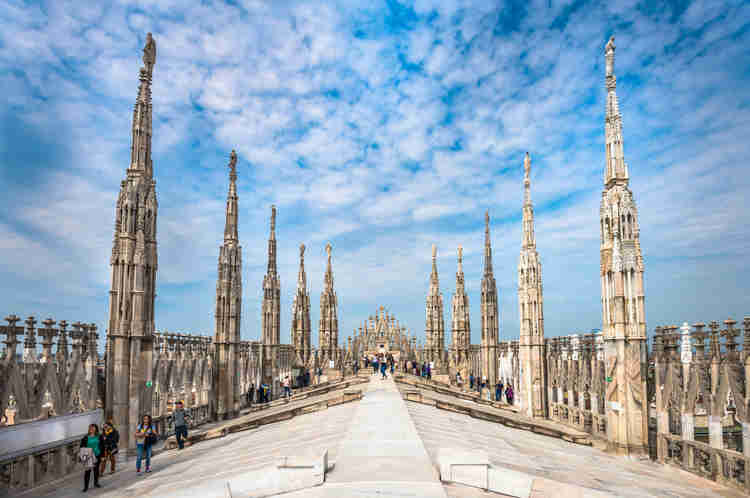
It’s one of Italy’s most beautiful churches, second in size in Italy only to St. Peter’s Basilica in Rome.
The Duomo is the most popular attraction in Milan. You need to book tickets in advance to avoid sell outs or long lines.
Click here to pre-book a skip the line ticket for both the Duomo and the rooftop terrace. When you arrive at the Duomo, make sure to get in the fast track line.
Click here to book a ticket + guided tour of the duomo. Click here to book a ticket for access to just the rooftop terrace.
The Pinacoteca di Brera is one of Europe’s best (and most underrated) museums. Its exquisite collection is housed inside the beautiful late 17th century Palazzo Brera near the Duomo.
The museum boasts works from the 14th to 20th centuries, including important pieces by artists such as Raphael, Caravaggio, Guercino, Bellini, Hayez, and Titian.
>>> Click here to pre-book a ticket to the museum.
You can tour Milan’s must see sites in one day. But you’ll need to be efficient and tightly planned.
I won’t repeat myself. Here’s my 24 hour step by step itinerary to make the most of your one day in Milan with tips on what to see/eat/do.
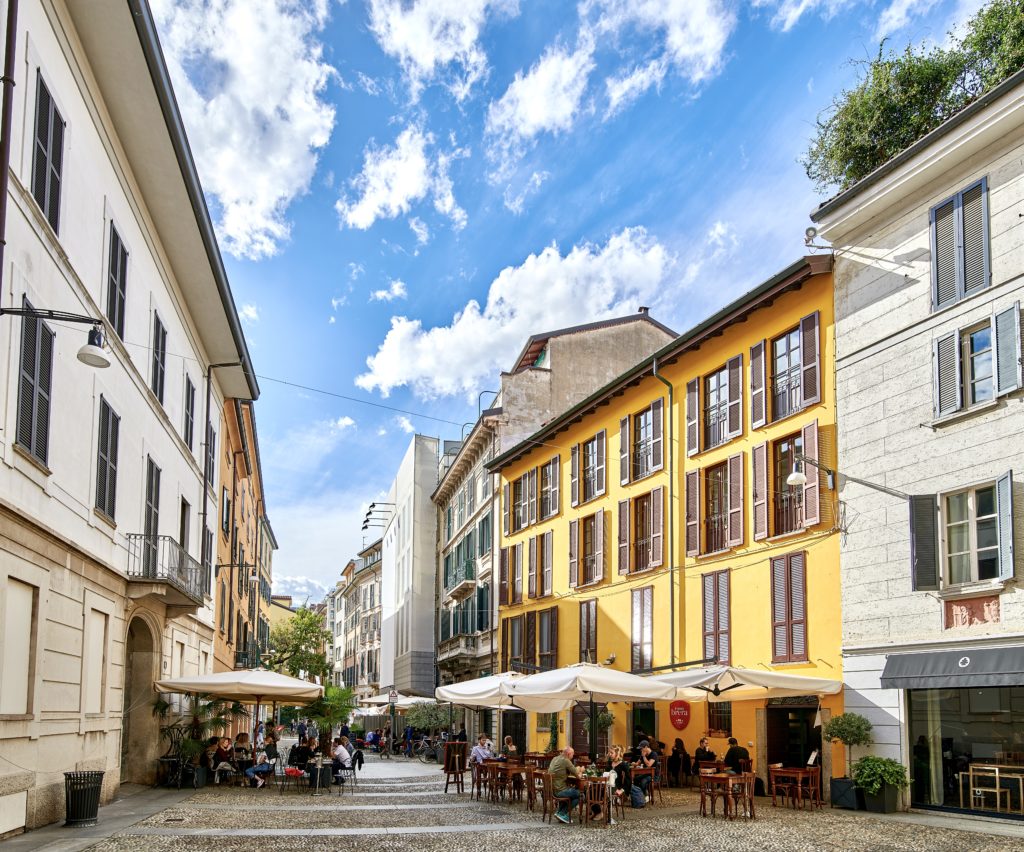
Where To Stay in Milan
Milan has some of the finest hotels in Italy. You’re spoiled for choice.
For an opulent stay, try the Bulgari Hotel Milano. It’s in the high end shopping district.
Or book at the Four Seasons, which has a lovely setting in a former convent. It’s a cut above the Bulgari.
The Park Hyatt has a great location near many of Milan’s top attractions and a Michelin star restaurant. The Hotel Principe di Savoia is a beautiful place that’s slightly off center if you want to escape crowds.
If you like boutique hotels, my picks are the Room Mate Giulia (trendy place near the Fashion district), the chic Hotel Magna Pars (in the Navigli), the Palazzo Segreti (elegant hotel near the Duomo), and the Antica Locanda dei Mercanti (in a beautifully restored townhouse).
Day 2: Drive to Bologna, Visit Parma En Route
If you want to spend another day in Milan, just skip Parma and overnight in Milan. If you want to head to one of Italy’s prettiest towns, stop in the lovely and underrated town of Parma.
It’s just 2 hours from Milan. It’s one hour+ further from Parma to Bologna, your next destination.
Parma is a UNESCO City of Gastronomy. Plan on lunch at Carne-Copia or F.I.S.H. Restaurant.
Though known for its fine cuisine, Parma also satisfies appetites for art, music, and history. It was home to the artist Correggio, the opera composer Giuseppe Verdi, and the conductor Toscanini.
Parma is a sweet and colorful city. It has a pink Baptistery, precious Correggio frescos, and art-filled palaces. The entire town is dotted with red and yellow walls. Purple flowers cover the Ponte Verdi.
Parma is the place to take a Correggio course.
You can find beautiful Correggio frescos in the cupola of Parma’s Duomo, in the interior dome of San Giovani Evangelista Church, and in the Camera di San Paolo in the Benedictine monastery of St. Paul.
The Palazzo della Pilotta complex is also a must do in Parma. It’s a former palace that houses museums dedicated to art and archaeology.
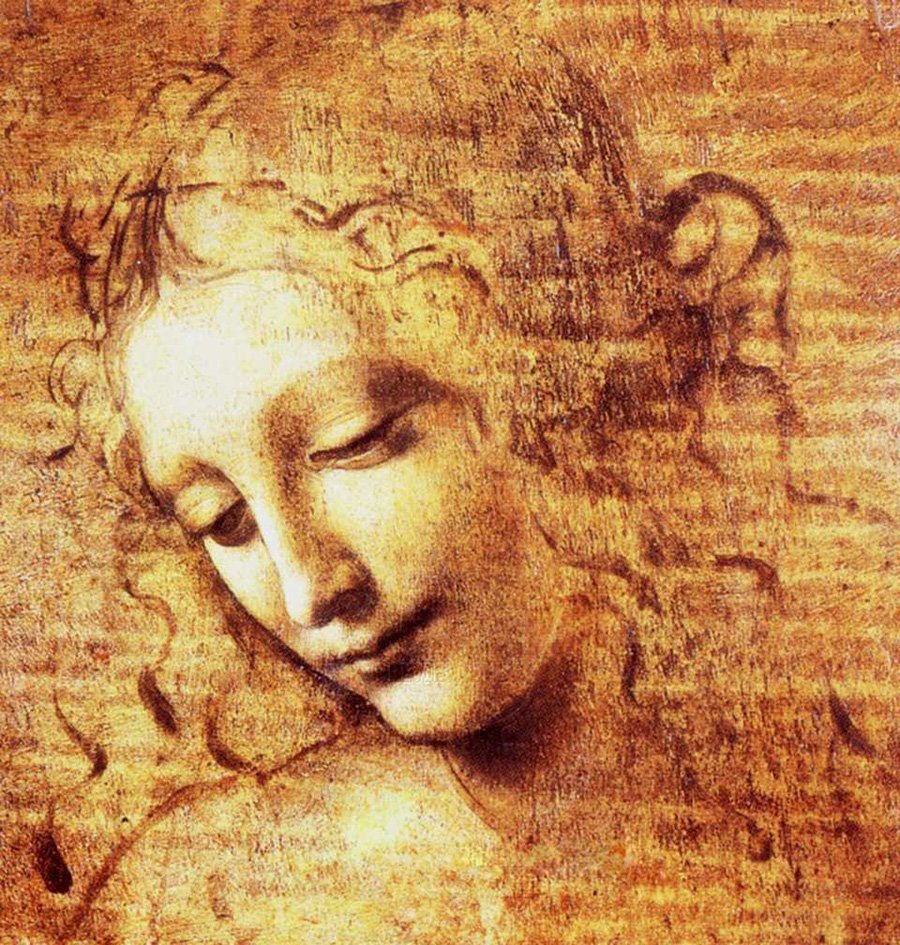
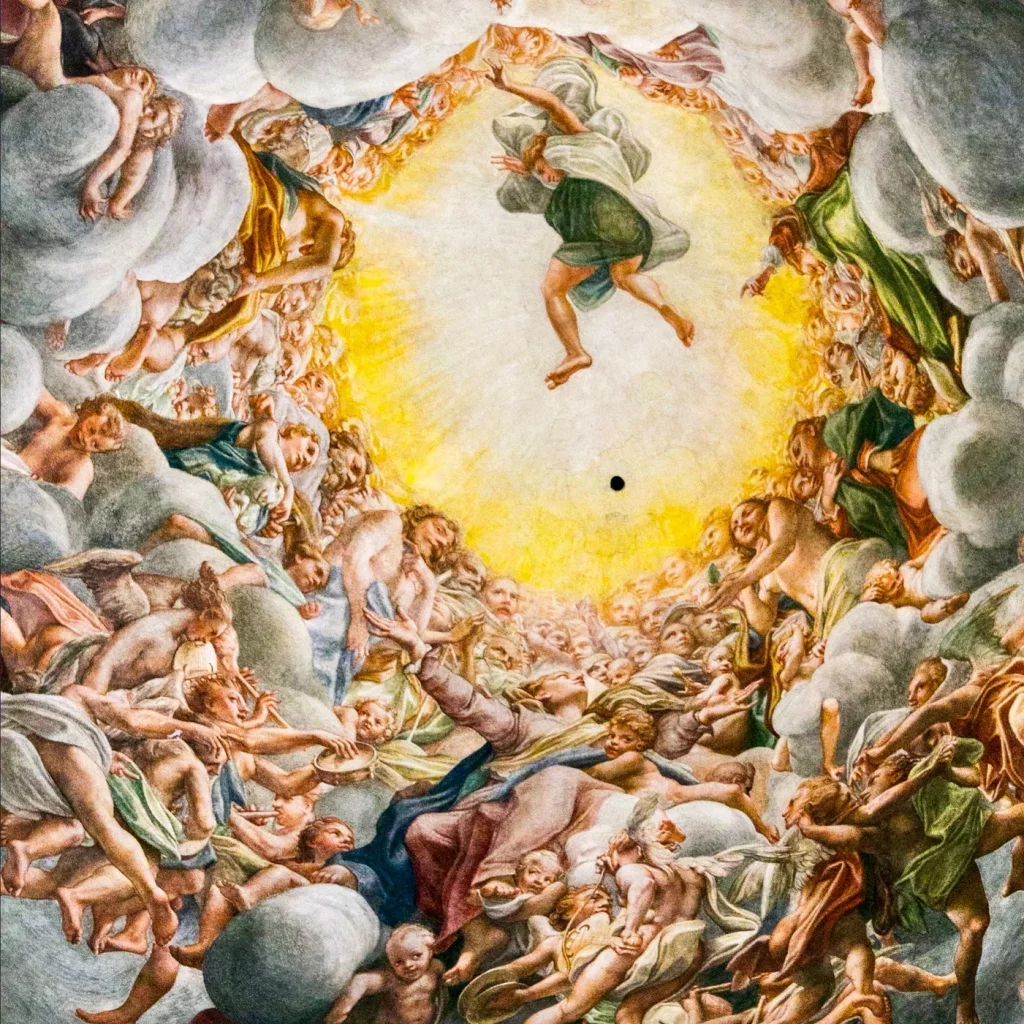
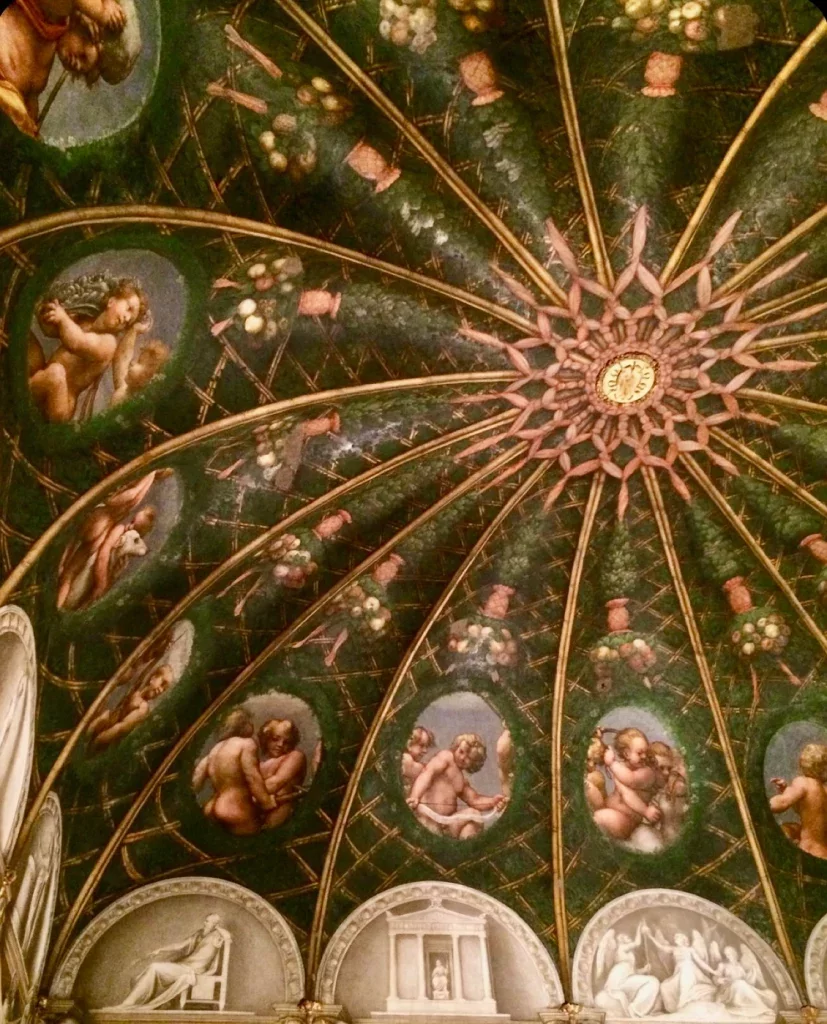
You enter via the Teatro Farnese, a beautiful wooden theater that will leave you gawking.
The High Renaissance art works in the Galleria Nazionale will have the same effect. You’ll find a rare Leonardo da Vinci, Canaletto cityscapes of Venice, and more Correggios.
Before leaving, have an aperitif at T Time, which overlooks the octagonal medieval baptistery.
Then grab an early dinner at Borgo20, before hitting the road to Bologna to overnight there. It’s a 1:15 drive to Bologna.
Day 3: Explore Bologna
On day 3 on your 10 days in Italy itinerary, you’ll explore the underrated city of Bologna. Bologna is nicknamed La Grassa, or the Big Fat, for its delicious food.
Bologna just oozes medieval charm. Bologna is a bit of a hidden gem in Italy. But it shouldn’t be.
Bologna is a historic city filled with striking architecture, stony piazzas, a swathe of palaces and towers, and gourmet restaurants. Bologna specializes in tortellini, tagliatelle, ragù, cured hams, and mortadella. Don’t start a diet here!
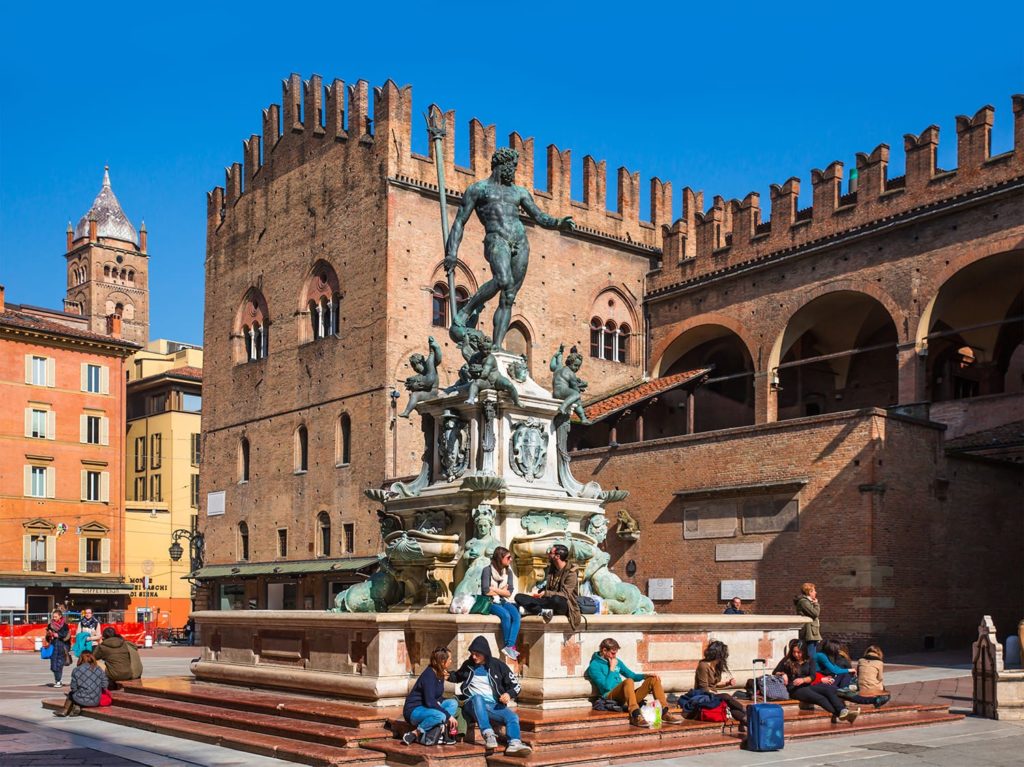
Bologna’s must see sites are mostly situated in the city’s main square, the massive Piazza Maggiore. You may want to book a guided 2 hour walking tour of the city center or this 3 hour classic guided tour.
In the square, you’ll be greeted by a huge statue of a virile Neptune atop a fountain. It was created by one of the great late Renaissance sculptors, Giambologna, who was second only to Michelangelo in skill.
On one end of the piazza is the massive Basilica of San Petronio, honoring Bologna’s patron saint. The basilica terrace offers a stunning view of Bologna’s major monuments.
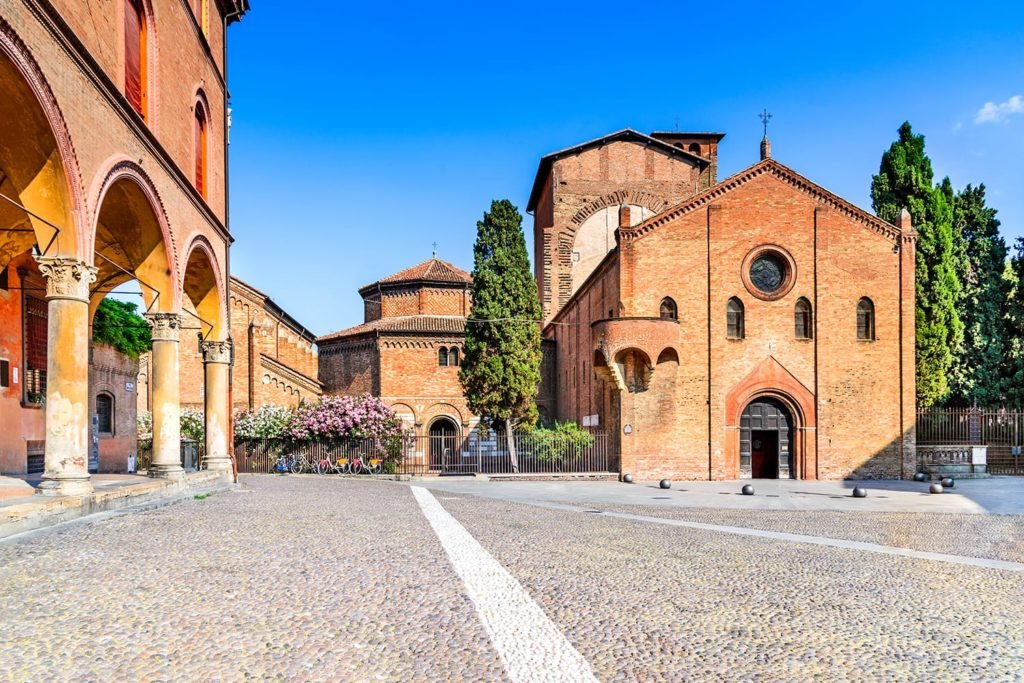
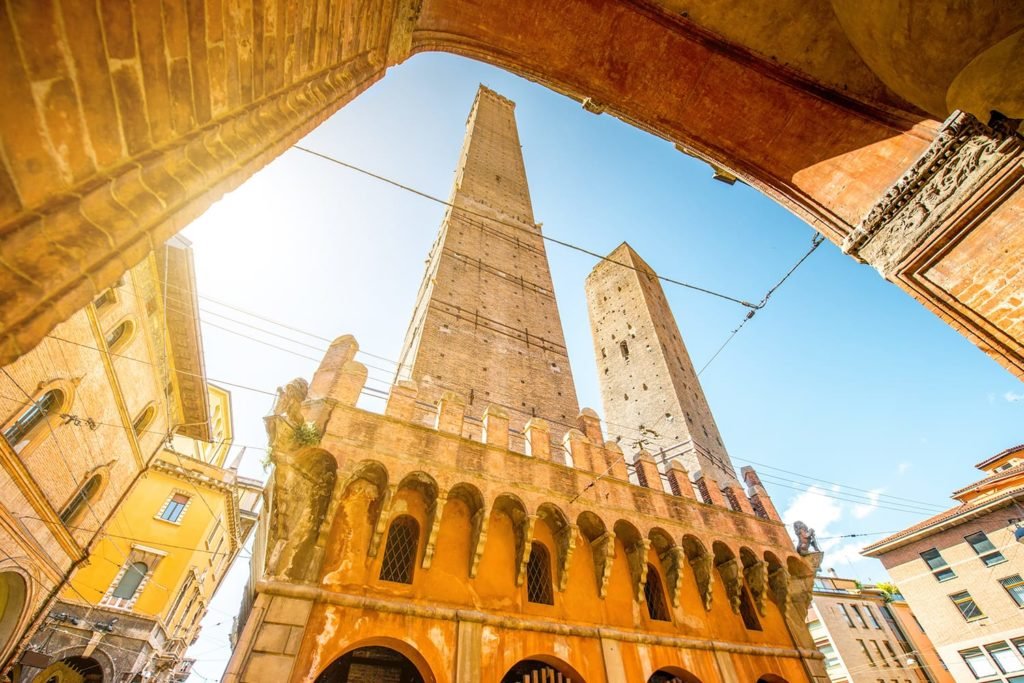
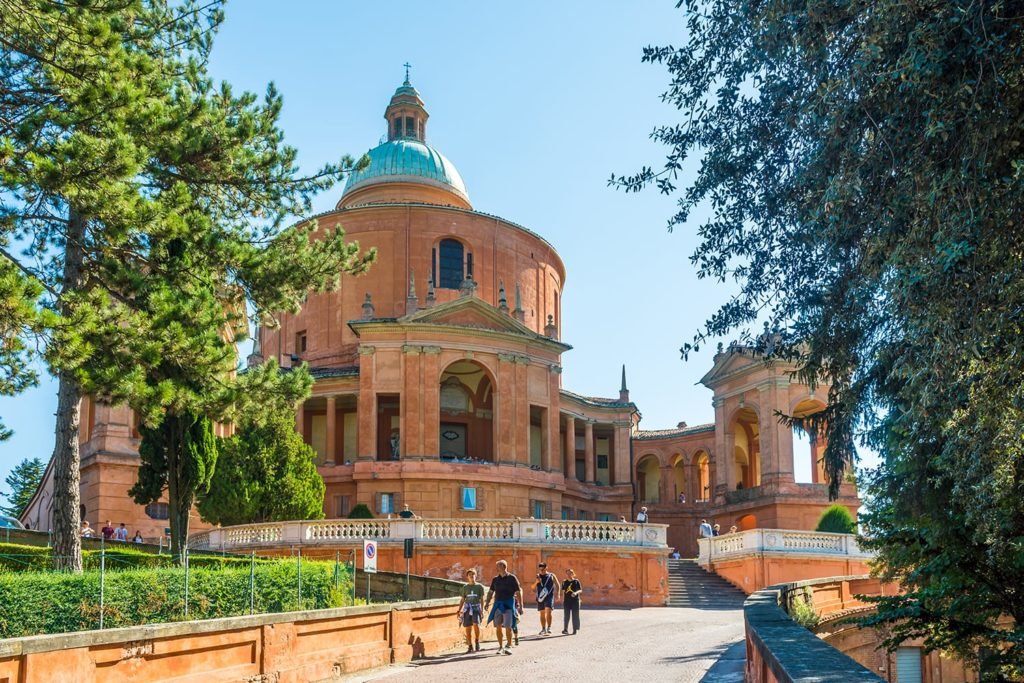
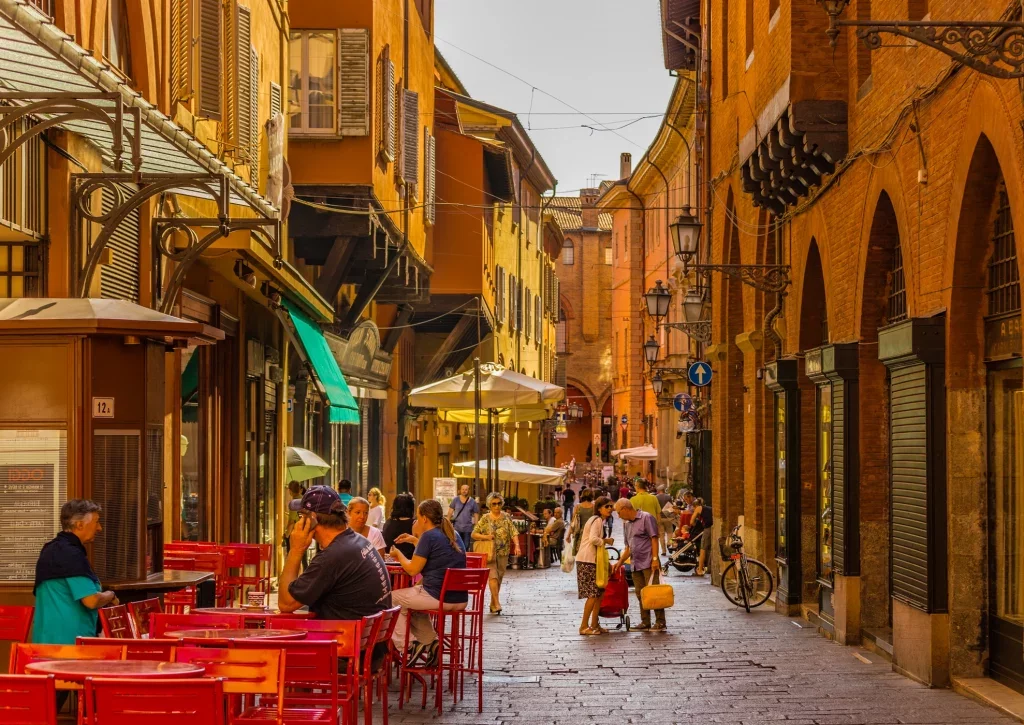
On the other end of the piazza is the swishy Palazzo dei Rei Enzo. Just south of the square is the elegant Piazza Galvani and some of Bologna’s finest porticos around Via Farini.
Have lunch at Ristorante da Nello al Montegrappa, just off the Piazza Maggiore. Or try out Bologna’s new hotspot for pizza, Ranzani 13.
Then, head to Bologna’s most famous site and most beautiful church, the grand Gothic Santo Stefano Church.
It’s a complex of seven churches, founded by Petronio atop a Roman temple. Legend holds that, when Dante was expelled from Florence for his politics, he wiled away time in the Romanesque cloisters.
Then head to Bologna’s old medieval neighborhood, the Quadrilatero. Meander through the medieval lanes filled with deli shops and food markets.
Move on to the Piazza di Porta Ravegnana where Bologna’s Le Due Torri, or two leaning towers, presides.
You can climb 500 steps of the Asinelli Tower for panoramic views. Have a gelato or meal in the pretty piazza.
Be sure to walk under Bologna’s famous 666 Portico at some point while you’re in the city. It’s the world’s longest terra cotta arcade.
The portico stretches over 2.5 (sometimes arduous) miles from the Bonaccorsi Arch to the 17th century Sanctuary of the Madonna of San Luca. You’ll have spectacular views from the sanctuary.
For dinner, click here for a fantastic guide to eating like a local in Bologna.
Bologna is also a fantastic place to book a guided food tour. You can book a 3 hour “10 tastings” tour. Or this classic 4 hour walking tour that takes you to markets, coffee shops, and osterias.
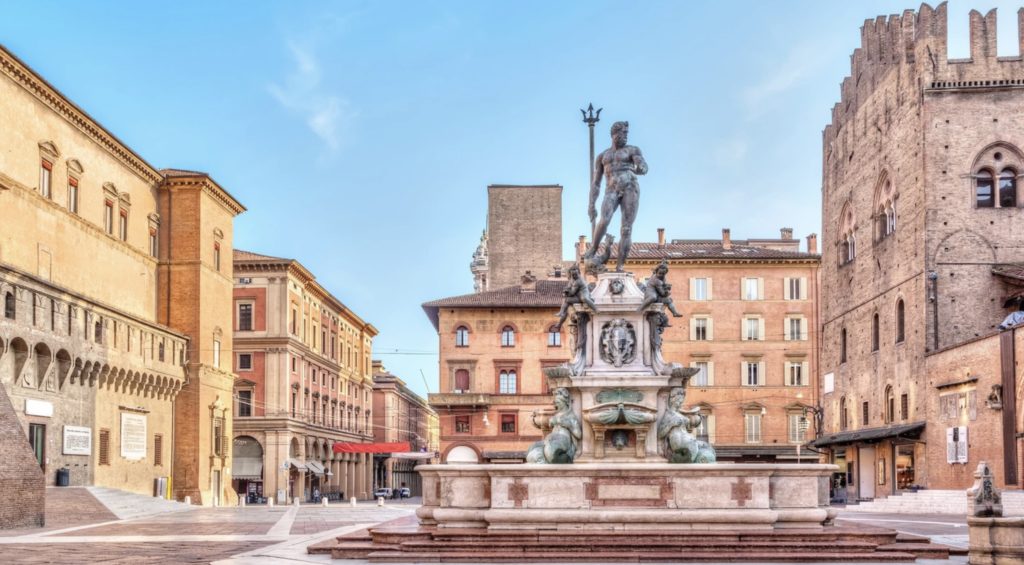
Where To Stay In Bologna
Probably the best hotel is the Grand Hotel Majestic Gia Baglioni. It’s the only five star hotel in the city with Carracci frescos. The Hotel Corona d’Oro is a luxury boutique hotel in a 15th century palazzo.
Il Portici Hotel is a lovely hotel that’s centrally located and has a Michelin restaurant. The Art Hotel Orlogio is a stylish hotline a quiet and picturesque side street.
If you want the feel of a country estate, check out the Savoia Hotel Regency. It has classically decorated rooms and an outdoor pool.
Day 4: Explore Lucca
The next morning, drive to Lucca. You’ll need to park your car at a paid car park outside the city walls.
Beautifully preserved Lucca is still entirely contained within its stout Renaissance walls, designed by Leonardo da Vinci. Happily, Lucca never tore them down, like many Italian towns did to make way for modernity.
Now, the walls are like a circular park for pedestrians and bikers. Walking the entire wall takes about 1 hour.
Lucca doesn’t really have any must see sites, which means it’s under the radar for most tourists. Lucca’s appeal lies in its relaxed old world charm.
It’s best to stroll along the pretty cobbled streets and piazzas. Romanesque churches are around every corner.
The main pedestrian drag is Via Fillungo. Lucca’s central square, Piazza Anfiteatro, was build around an ancient Roman arena.
There’s no remnants of the arena. But the handsome oval curve — ringed with yellow medieval buildings — still sits pretty. Take a break for lunch at Lucca’s best pizza joint, Da Felice, in the historic center.
In Piazza San Michele, you’ll find the lovely Church of San Michele, with a steep white marble Romanesque facade. In Piazza San Martino, you’ll find the ancient Cathedral of San Martino, with a fetching brick and marble facade.
The cathedral was built to house one of Christendome’s most famous relics, the Volto Santo.
It was reputedly carved by Nicodemus, the man who helped depose Christ from the cross. The relic is kept in the freestanding Tempietto. Climb up the belfry for views of Lucca.
In its heyday, Lucca had over 100 towers, reminding me of Regensburg Germany. They were the homes of wealthy merchants families. The tallest surviving tower, the 14th century Torre delle Ore, is fetchingly capped with a bushy forest. You can climb this tower too.
End your day with dinner at Ristorante Gatta Ci Cova or Ristorante Giglio.
READ: 10 Day Itinerary for Tuscany
Where To Stay In Lucca
The top pick in Lucca is the Palazzo Dipinto, right in the historic center. Hotel Palazzo Alexander is another pretty place in the town center. Hotel Villa Casanova is set within an 18th century farm house amid the hills.
Day 5: Day Trip to Cinque Terre or Pisa From Lucca
On day 5 of your Milan to Rome road trip itinerary, choose between a day trip to the Cinque Terre or to Pisa, depending on what interests you most.
The Cinque Terre is an iconic destination on the Italian Riviera of spectacular natural beauty and endless views. But it takes some effort and logistics to visit and can be extremely over-touristed in high season.
Pisa is a less hassle good alternative for culture vultures. Pisa will also be crowded in high season with visitors coming to “hold up” the Leaning Tower.
But Pisa’s UNESCO-listed Field of Miracles is a magnificent assemblage of art and architecture. Pisa itself is also a charming town.
1. Cinque Terre Day Trip
The Cinque Terre is a series of 5 Italian villages set in craggy cliffs. They are Riomaggiore, Vernazza, Manarola, Monterosso, and Corniglia.
You’ll have dramatic views of sugar cube cottages, olive groves, terraced vineyards, and the Mediterranean Sea.
Cinque Terre is very doable as a day trip from Lucca. You can book a guided full day tour from Lucca.
If you take your car, drive to La Spezia. Park at one of the many lots, and take the train (7 minutes) to Riomaggiore from there. Alternatively, drive to the first town, Riomaggiore, and park in the small lot there (likely full in the summer).
To get around the villages, either hike along goat paths (best option), hop on the milk train, or take a ferry ride. Check to make sure the hiking trails are open.
Start at Riomaggiore. Wander the charming lanes and climb the Catello di Riomaggiore. Grab a quick bite to eat at Bakery Rosi Roberta di Baudinelli. Then head to Vernazza.
Vernazza is widely considered the most postcard-perfect town in Cinque Terre. For the most spectacular views of your day, climb Castello Doria.
Hang out in Piazza Marconi, with a sea of cafes. Before hitting the next village, grab a gelato at Gelateria Vernazza.
Then head to Monterosso, the largest of the Cinque Terre towns. Explore the quaint medieval old town behind the harbor. Pop into the Church of San Giovanni Battista.
That’s probably all you’ll have time for in one day. I’d head back to Lucca for dinner, since the food will be superior to the Cinque Terre.
2. Pisa Day Trip
Historic Pisa is only 30 minutes from Lucca. Most travelers in Tuscany descend in droves on tiny Pisa.
They come for Pisa’s famously Leaning Tower on the spectacular UNESCO-listed Field of Miracles. You may want to take a guided tour to get the full lowdown.
I think the tower is at tad overrated. It leans because it’s a product of poor engineering and soft soil, nothing else. If you want, climb the spiral staircase for magnificent views.
But you have to book a ticket in advance to ensure a spot. You may want to do this weeks ahead of time, to ensure a timed entry slot.
The real gem of the Field of Miracles is Pisa’s exuberant Duomo. It’s the most ancient cathedral in Italy, older than the cathedral complexes in Siena and Florence.
This Romanesque edifice was founded in 1118. The exterior is decorated with alternating black and white stripes.
Inside, there’s a central nave and two flanking aisles on each side, with intricate Corinthian columns and arches.
In the apse, you’ll find mosaics attributed (perhaps erroneously) to the greatest 13th century Italian artist, Cimabue.
There’s also an elaborate 14th century pulpit carved by Giovani Pisano and works by Ghirlandaio and Giambologna.
The other great monument in Pisa is the circular monument in front of the Duomo, the Baptistery. Begun in 1153, there’s still a full immersion baptismal font inside.
From the Women’s Gallery above, you have views of the font. There’s also a beautifully carved pulpit, created by Giovani’s father Nicolo Pisano. It’s considered one of the first works of Renaissance art.
The dome covering the Baptistery is actually two domes, which produces an odd acoustical effect.
For a tip, the guards will sing and you can hear the melodic reverberations. Like the Leaning Tower, the Baptistery is on unstable soil and leans slightly toward the Duomo.
When you’re done on the stunning Field of Miracles, visit the historic town itself, strolling along the Arno River. There are museums, palazzos, and piazzas to check out. If you want to stay in Pisa for dinner, try Spaghetteria Alle Bandierine or Osteria di Culegna.
You can either overnight in Lucca again, which my itinerary contemplates. Or, you can push on to Florence and spend 3 nights in Florence instead of 2 nights. It’s a 1:10 drive from Pisa to Florence.
READ: Must Know Tips for Visiting Pisa
Day 6: Explore Florence
On Day 6 and 7 of your Italy itinerary, you’ll explore my favorite city in Italy, Florence.
Florence is an overwhelmingly beautiful city, the “Cradle of the Renaissance.” With the best Medieval and Renaissance art in Europe, Florence is a veritable art lovers paradise.
Florence’s entire historic center is a designated UNESCO World Heritage site. You’ll need to buy your tickets for major attractions and must see sites well in advance.
1. Florence Cathedral Complex
To kick off day 6 of your 10 days in Italy, head to the historic complex of Florence Cathedral, Santa Maria del Fiore, nicknamed the Duomo.
The Duomo complex consists of the Duomo, the Baptistry, the Giotto Bell Tower, and the Duomo Museum. They’re all eminently worth seeing.
You may want to book a guided tour of the Duomo itself. You can also book a guided tour of the Duomo that includes access to the dome and secret terraces that you wouldn’t see on a regular visit.
It’s absolutely essential to pre-book a ticket to climb Brunelleschi’s dome.
You should start with the stunning Duomo Museum to get the historical backdrop for all these structures.
The museum is housed in the Piazza del Duomo at the back of Giotto’s Bell Tower, behind the Duomo apse.
The museum space is a fabulous treasure box of sculpture. Its rooftop terrace also offers a mesmerizing view of Brunelleschi’s dome.
Then, head to Florence Cathedral — the most prominent, and popular, landmark in Florence. It was built over 172 years, beginning in 1296. Florence Cathedral is made of brown sandstone and beautifully faced or “frosted” with pink, green, and white marble.
Filippo Brunelleschi’s magnificent terra cotta colored dome, built from 1420-36, is the highlight.
The burnt orange cupola is the very symbol of Florence. It’s decorated with frescos by Giorgio Vasari, a Florentine artist and the world’s first art historian. For panoramic views, climb up the cupola.
Next, stroll to the Baptistery, in front of the main facade of the Duomo. Dating from 1059, it’s over a thousand years old.
The Baptistery sports three magnificent sets of bronze doors. designed by Lorenzo Ghiberti and Nicola Pisano. Inside, is a stunning golden Byzantine style ceiling mosaic telling the story of the Last Judgement.
Break for lunch and a wander, enjoying the joys of a traffic free Florence.
Try Casa del Vino, where you can get sandwiches, crostini, or charcuterie plates with a delicious glass of wine. All’Antico Vinaio is also a must try, just minutes away from Piazza della Signoria.
2. Ponte Vecchio
Then, take the classic stroll across Florence’s storybook bridge, the Ponte Vecchio. It looks like cobbled together houses suspended over the Arno River.
The bridge has three arches topped with a jumble of charming shops. Nowadays, you can buy expensive jewelry on the Ponte Vecchio.
3. Uffizi Gallery
In the afternoon, head to the Uffizi Gallery, Florence’s #1 sight. It houses the world’s best and most abundant collection of Italian Medieval and Renaissance art. The museum is a crowd pleaser, the third most visited site in Italy. The Uffizi deserves its accolades.
The Uffizi boasts seminal works from the 13th to 18th centuries. Here’s where you’ll find one of the world’s most iconic paintings, Sandro Botticelli’s Birth of Venus. If your time is limited, you should focus your efforts.
The must see halls include the Hall 2 (Giotto), Hall 8 (Lippi), Halls 10-14 (Botticelli), Hall 15 (Leonardo), Hall 41 (Raphael and Michelangelo), Hall 83 (Titian), and Hall 90 (Caravaggio).
READ: Complete Guide to the Uffizi Gallery & Tips For Visiting the Uffizi
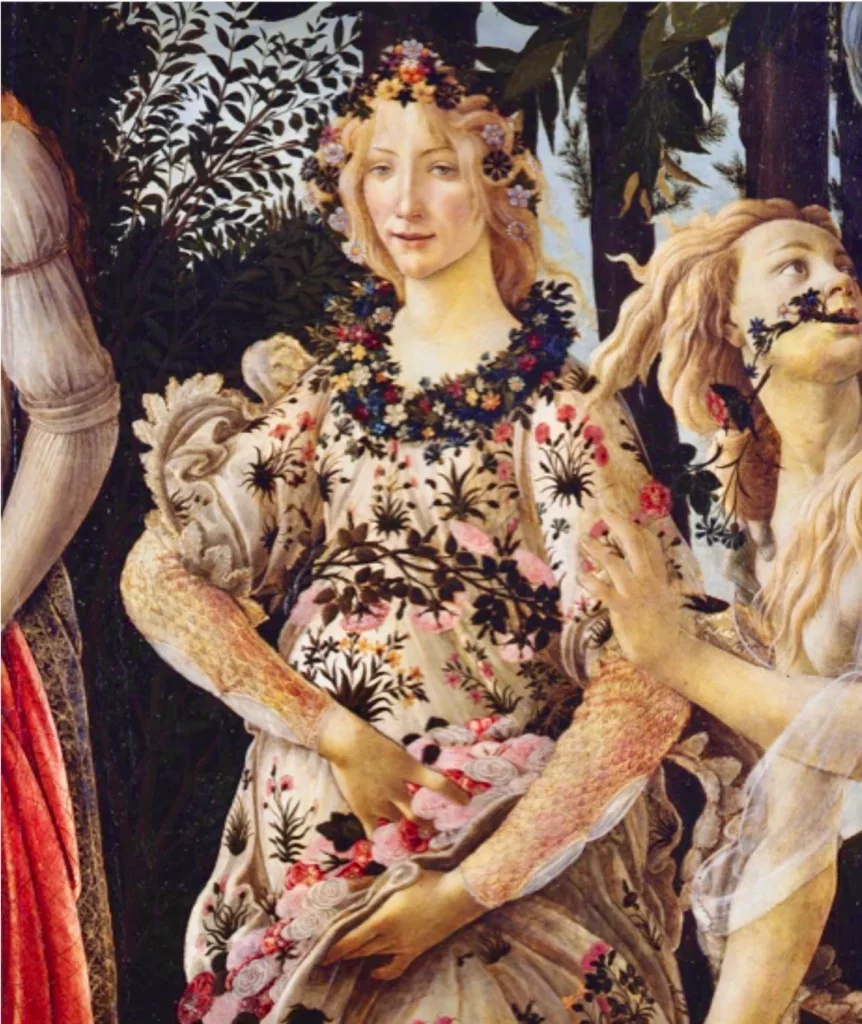
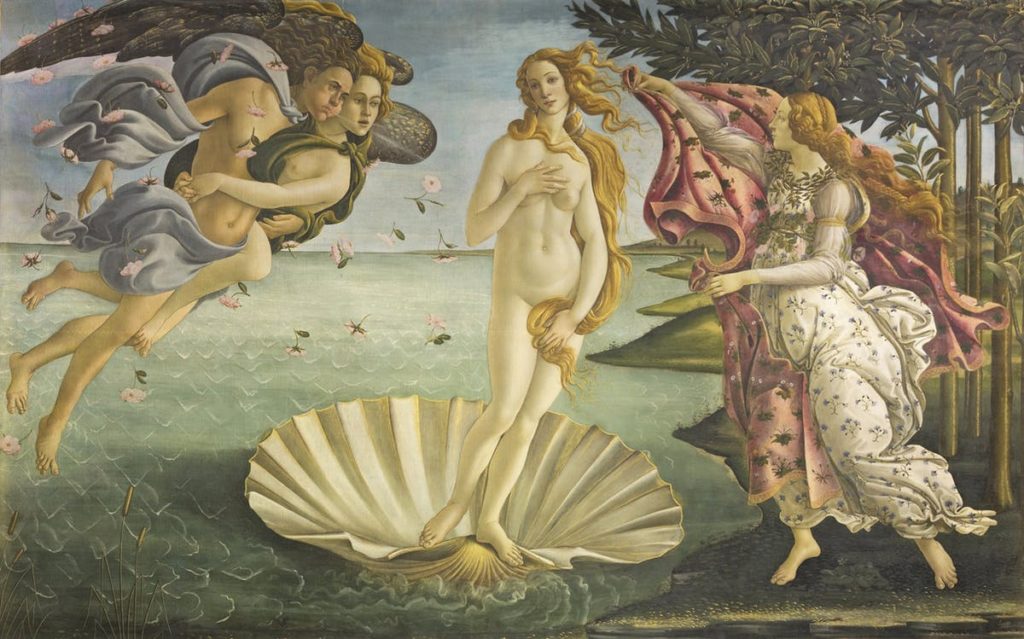
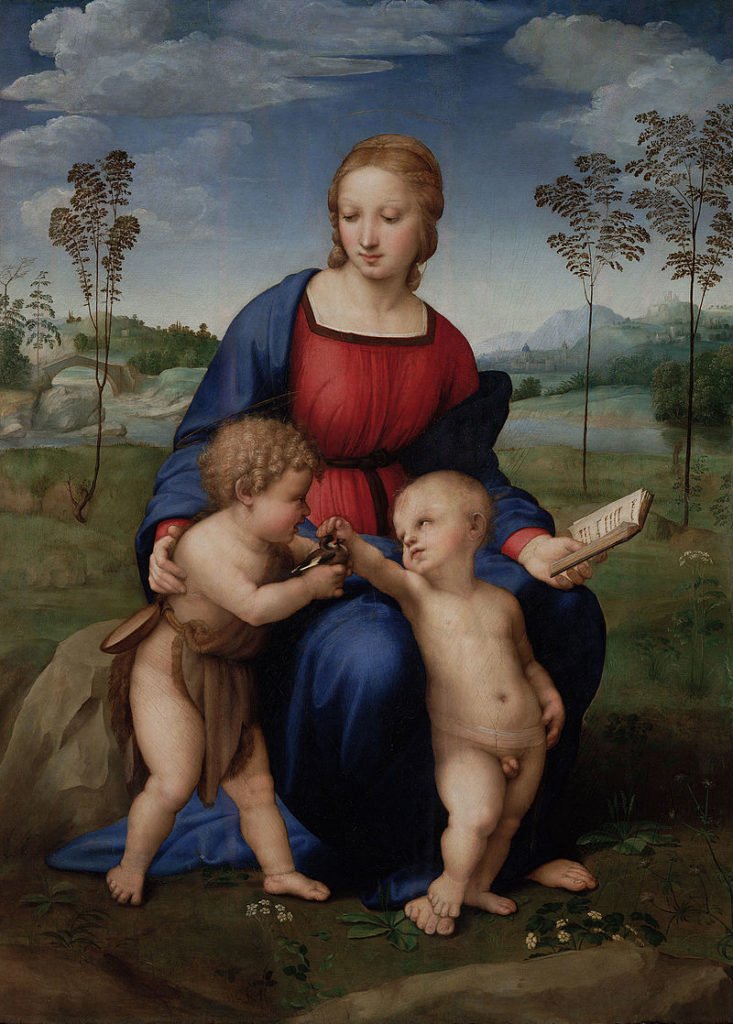
The Uffizi is famous for its long lines. You don’t want to waste precious sightseeing time standing in them.
Click here to pre-book a skip the line ticket.
The Uffizi is also a popular place to take a guided tour, because of its history and the sheer number of masterpieces. And this is another way to procure your all important skip the line ticket.
You have several options:
- 1.5 hour small group guided tour
- 2 hour small group guided tour
- 2 hour private tour
- 2 hour early entry guided tour (8:30 am)
4. San Miniato al Monte
Finally, head to one of Florence’s iconic viewpoints. Piazzale Michelangelo is the classic lookout point.
But if you hike 10 minutes further uphill, you’ll come to the Basilica of San Miniato al Monte, Florence’s crowning glory.
The ancient church is a unique and harmonious blend of medieval architectural styles, pre-dating Florence’s Renaissance treasures. Behind the church is a monumental cemetery with beautiful funerary art and sculptures.
At night, get an apertivo at the atmospheric Osteria dell’Enoteca. For dinner, indulge at Trattorio de Tito, not far from the Accademia, or Bobo’s Trattoria.
Day 7: Explore Florence
1. Michelangelo’s David
Start you morning bright and early at the Accademia Gallery. After the Uffizi, the Accademia is Florence’s most visited museum.
People flock in to see what is probably the world’s most famous sculpture, Michelangelo’s commanding statue of David.
The 17 foot sculpture is considered the embodiment of male beauty, a Calvin Klein-like model of physical perfection. David was commissioned for a niche of the Duomo. But it was considered too beautiful for that location. It’s essential to have a reservation for the Accademia.
Heres my guide to Michelangelo’s David. You should definitely pre-book a skip the line ticket for this popular Florence attractions. You can also opt for a 1.5 hour guided tour with fast track ticket.
2. San Marco Monastery
When you’re done at the Accademia, head just a few blocks to another amazing Florence art spot, the Museum of San Marco Monastery.
San Marco is an extraordinary decorative complex, one of the most unusual things to do in Florence. You can admire art in its original in situ location and understand how contemporary audiences experienced it.
At this Renaissance convent-museum, you travel back in time to a nearly perfectly preserved 600 year old Dominican monastery.
It was paid for by Medici family money, designed by the stellar architect Michelozzo, and decorated with delicate frescos by one of the best painters of the Renaissance — Fra Angelico.
The fiery preacher Girolamo Savonarola even lived there, in the monks dormitory cells.
Here’s my complete guide to San Marco Monastery. Click here for a skip the line ticket. Click here for a fascinating tour that gives you insight into Fra Angelico, Savonarola, and the Medici.
You’re likely ready for lunch. This is a good time to explore the San Lorenzo markets.
There are two of them, an outside street market and an indoor food court known as the Central Market. I can recommend a rustic gem, Trattoria la Burrasca, on the market’s north corner.
3. Santa Maria Novella
After lunch, tour the beautiful Basilica of Santa Maria Novella and the Piazza della Repubblica. Santa Maria Novella was founded in 1279 by a Dominican order.
The basilica has a similar design to the Duomo. Polychrome and white marble create a striking front facade.
The interior is a true marvel. It holds one of the most famous paintings in Italy, the Holy Trinity by Early Renaissance artist Masaccio. You’ll want to inspect three important highlights — the Strozzi Chapel, the Filippo Chapel, and the Spanish Chapter House.
Click here for a tour of Santa Maria Novella and its ancient pharmacy.
4. Basilica of San Lorenzo Complex
Next, head to the monumental complex of the Basilica of San Lorenzo. The complex is a veritable haven of Renaissance art and architecture, a must see for art and history buffs.
The complex is vast, including: the basilica itself, Brunelleschi’s Old Sacristy, Michelangelo’s New Sacristy, the Medici Chapels, the Medici Crypt, and the Laurentian Library.
Most importantly? It has the largest number of Michelangelo sculptures in Florence, quite a selling point. And a Michelangelo-designed library.
If you’re on the Michelangelo trail, the Medici Chapels and the Laurentian Library are must sees
The Medici Chapel absolutely requires pre-booking. Click here to purchase a skip the line ticket. Click here to book a guided tour.
5. Palazzo Vecchio & Piazza della Signoria
In the evening, head to the magnificent Palazzo Vecchio. It’s one of the few Florence attractions that’s open at night.
The Palazzo Vecchio was the seat of government and one of the three palace-residences of the Medici dynasty. It sits in the Piazza della Signoria, which is essentially a free open air sculpture gallery.
It’s definitely worth going inside the Palazzo Vecchio, though so many tourists don’t.
The Palazzo Vecchio is a doughty medieval fortress on the outside and a resplendant Renaissance palace on the inside.
You can admire the stunning Michelozzo-designed courtyard, explore the grand Hall of the Five Hundred, admire Michelangelo and Donatello sculptures, and gaze admiringly at the beautiful frescos by Giorgio Vasari at every turn.
Legend holds that a Leonardo fresco may be hiding behind a Vasari fresco.
The Tower of Arnolfo can be climbed, and provides fantastic views over Florence and the Duomo. And the lines aren’t nearly as long as for Brunelleschi’s dome.
Click here to pre-book a ticket to Palazzo Vecchio. Click here to book a 1.5 hour guided tour with fast track ticket.
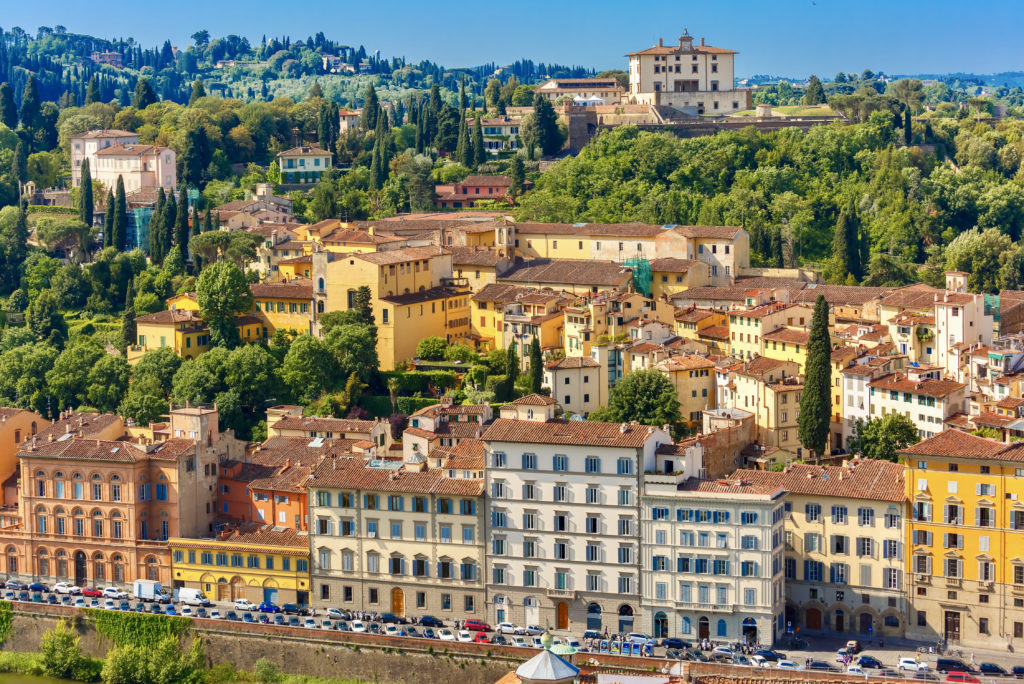
Where To Stay In Florence
There are plenty of amazing hotels in Florence. You’re really spoiled or choice.
If you want something central, book at the Hotel Brunelleschi or Portrait Firenze.
Portrait Firenze is one of the most sought after hotels in Italy and is just steps away from the Ponte Vecchio. Of course the Four Seasons is always beautiful and in a quiet location.
The Palazzo Vecchietti is housed in a beautiful 16th century townhouse. The St. Regis is a beauty too, right near Santa Maria Novella. Il Salviatino has a patrician feel and offers Duomo views.
In the Oltrarno, I really like Villa Cora with its stunning views and Renaissance style suites.
Day 8: Explore Siena En Route To Rome
On day 8 of 10 days in Italy, head to the stunning Tuscan town of Siena.
Beautiful Siena is only an hour from Florence. It’s one of the best cities to visit in Tuscany for its rustic medieval beauty, tasty food, and luscious chianti.
If you want to bask in medieval times, there’s no better place. I guarantee you’ll fall in love.
You’ll want to spend ample time strolling through the pedestrianized historic center. It’s a well-preserved burnt orange dream littered with cute cafes and shops.
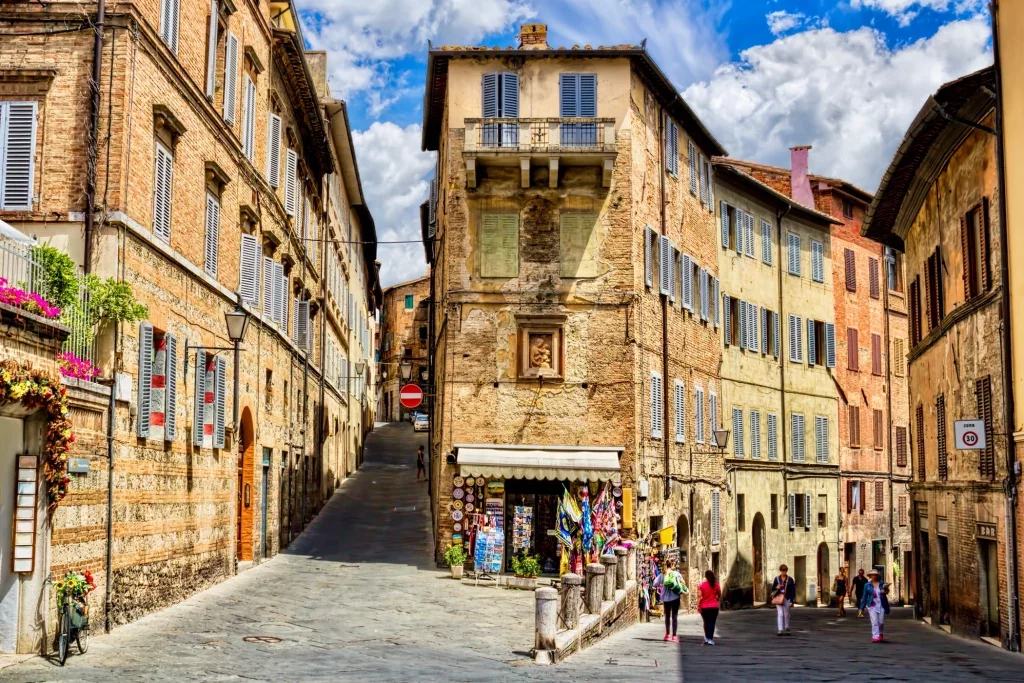
With literally every cultural activity imaginable, stroll-able medieval Siena really deserves more than a day to soak up its rose-hued charms.
But Siena is compact and can be managed in 24 hours, if you’re efficient. I’ve written a one day itinerary for Siena.
It takes you to Siena’s must see architectural sites, museums, and piazzas. You’ll stroll through the pedestrianized historic center, which is a well-preserved burnt orange dream littered with cute cafes and shops.
Siena’s most famous site is its Duomo, Siena Cathedral. It’s one of Europe’s most beautiful churches, especially for lovers of all things Gothic.
It’s the symbol of Siena, clad all over in Siena’s trademark white and dark green marble. Consistent with the Gothic ethos that “more is always better,” every inch is decorated with marble, mosaics, sculptures, and frescos.
>>> Click here to pre-book a ticket. Click here for an amazing private guided tour of the cathedral.
Don’t stay too late in Siena. It’s over 2.5 hours to Rome. When you arrive in Rome, drop your car off. You won’t need or want it in Rome.
If you have an extra day in this area, considering stopping and overnighting in beautiful Orvieto en route from Siena to Rome. Orvieto is an elegant cathedral hill town only 1.5 hours from Rome.
Day 9: Explore Rome
Day 9 of your 10 days in Italy itinerary finds you in Rome, the Eternal City. Founded by the twins Romulus and Remus in 753 B.C., Rome once ruled the entire known world.
Rome is a breathtaking concentration of history, art, and charm — every corner could fill your eyes, your camera, and your typical American romantic comedy.
Rome has so much to offer and discover — historic landmarks, mind blowing art, charming neighborhoods, and perfect wine bars. You’ll have to be efficient to see all Rome’s major sites in 2 days.
Begin with the Imperial tour of Rome, which includes the iconic Colosseum, Palatine Hill, and the Roman Forum. These sites are among the most famous landmarks in Italy. They can be visited with one ticket and are Rome’s biggest draw.
Click here to book skip the line tickets for these three sites.
Day 9 AM: Imperial Ruins
1. Tickets & Tours
It’s good idea to book a guided tour of the imperial ruins, so you know what you’re looking at. Here are some tour options you can choose from. They all vary slightly in duration and what you see.
Pick one that best suits your sightseeing agenda and time allocation. Recently, I’ve done the fourth and fifth one on this list and loved the tours.
- skip the line entry tickets to all 3 sites
- 3 hour guided tour and entry to all 3 sites
- tickets & tour of all 3 sites + underground Colosseum access
- Colosseum tour with entry tickets for Palatine Hill and the Roman Forum
- skip the line private guided tour with an art historian
2. Colosseum
The 600 foot high Flavian Amphitheatre, nicknamed the Colosseum, was inaugurated in 80 A.D. with a grand 10 day festival.
Since then, it’s been synonymous with gladiators, chariots, and the emperor’s famous “thumbs up or thumbs down” edict.
In the arena, gladiators and wild animals fought to the death. The top level of the Colosseum was reopened in 2017. It provides sweeping views and may be the highlight of your visit.
If you’re DIY-ing the Colosseum, you need to reserve your entry time online well in advance. This is true even if you have a skip-the-line Roma Pass.
If you buy your ticket directly from the official website, you will specify the exact time and date. You can’t visit the Colosseum without a reserved entry time!
3. Palatine Hill
On Palatine Hill, you’ll see where the rich and famous of Imperial Rome lived. Built circa 81 A.D., the sprawling Domitian’s Palace is the most impressive ruin.
Emperor Domitian was a member of the Falvian dynasty. Unlike his father Vespasian and his brother Titus, who were civic minded, a megalomaniacal Domitian was only interested in palatial architecture.
While you’re on Palatine Hill, be sure to pop in at least briefly to the Palatine Museum. The museum contains statues and frescos from imperial Palatine. The Augustus and Nero rooms are particularly delightful.
Audiovisual displays reconstruct the palaces’ luxury. Some of the most interesting archaeological sites on Palatine Hill are restricted can only be accessed with the S.U.P.E.R. Pass.
Here’s my guide to buy and use that specialty Rome S.U.P.E.R. pass.
4. Roman Forum
After Palatine Hill, you move on to the Roman Forum. I advise having a guided tour here.
There’s not much signage. It will be difficult to divine what you’re looking at without a guide to decipher the lovely rubble.
The forum is a rectangular valley running from Arch of Titus to the Capitoline Hill. The main road is the Via Sacre.
The forum was the beating heart of Rome, the seat of power, and its central showpiece. It was a grandiose district consisting of white temples, grand basilicas, and vibrant public spaces.
Day 9 PM: Monti, Capitoline Hill, Jewish Ghetto
1. Monti Neighborhood
When you’re done exploring the ruins, head to Rome’s adjacent Monti neighborhood, just 5 minutes away. Monti is Rome’s trendiest off the beaten path district.
Formerly a slum in ancient Rome, now it’s gentrified and packed with unique shops and hip eateries.
Be sure to get off the main drag and explore Monti’s cute side streets. If you want to grab a quick lunch, get avocado toast or a panini at Fehu.
Or pick a cute ivy covered cafe, like Aromaticus Monti or La Carbonara, to settle down and relax after your Imperial tour.
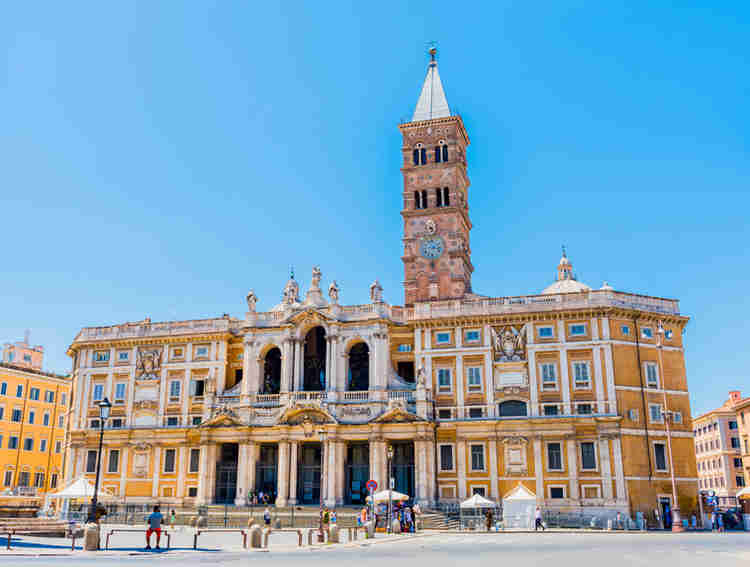
Monti has one absolute must see site — the Santa Maria Maggiore Church. Personally, I liked it better than St. Peter’s Basilica.
It’s much older, dating to the 5th century A.D. And it has absolutely breathtaking mosaics in the triumphal arch and nave. And it’s free to visit.
2. Capitoline Hill
When you’re done in Monti, head over to the the Vittorio Emanuel II monument on Capitoline Hill, also known as the “typewriter” or “wedding cake” building.
For views, hike up to the second floor. For even better views, take the glass elevator around the back up to the viewing terrace. It’s expensive at 10 euros, but totally worthwhile.
3. Capitoline Museums
Around the corner is Michelangelo’s stairway, rising to the Piazza del Campidoglio at the top of Capitoline Hill.
At the tip top is the Capitoline Museums, housed in two buildings connected by an underground passage.
Inside, are some of Rome’s greatest treasures — the statue of Marcus Aurelius on horseback, the original She-Wolf of Rome that suckled Romulus and Remus, and ancient statues.
Click here to pre-book a skip the line ticket to the Capitoline Museums. If you’re a true fan of ancient sculpture, you can also book a guided tour of the museum.
After visiting the museum, head down the alleyway on the right side of the square under an arched building. That will take you to a viewpoint over the Roman Forum.
This is the best view you’ll have of the forum. When hunger calls after this hectic day, head to the Jewish Ghetto neighborhood. It’s just a stone’s throw away, on the banks of the Tiber River. Try Ba Ghetto restaurant for dinner.
Day 10: Explore Rome
Day 10 AM: Centro Storico
Begin day 2 with a classic walk through Rome’s historic center. Start at Campo de’ Fiori and end at the Spanish Steps, visiting the Trevi Fountain, Piazza Navona, and the Pantheon along the way.
Here’s my guide to taking a walking tour in the historic center. You can book a 3 hour guided walking tour. You can also book a private guided walking tour of this beautiful part of Rome.
In the afternoon, choose between a visit to Vatican City or the Borghese Gallery with pre-booked skip the line tickets.
1. Campo de’Fiori
Start your morning in the Campo de’ Fiori, Rome’s colorful market square.
In the center is a statue of Giordano Bruno, a 16th century friar and philosopher who was imprisoned in Castle Sant’Angelo and burned at the stake for his scientific theories.
Here, you’ll find fresh produce and can pick up some souvenirs like olive oil, pasta, or limoncello.
Your next stop is the Piazza Navona. This famous square is a long rectangle, dotted with fountains by the foremost Baroque sculptor, Gian Lorenzo Bernini. It dates back to the time of Domitian, who used it as a racetrack.
2. Pantheon
Then you’re off to Rome’s most famous temple, the 2,000 year old Pantheon, set in a lively piazza. Built by Emperor Hadrian, this is my favorite building in Rome.
The entrance boasts massive 40 foot single piece granite columns. Inside is a magnificent dome with a giant oculus (or eye in the sky) that inspired the domes of St. Peter’s Basilica and the Duomo in Florence. If it’s raining, water falls through the oculus and out the drains in the floor.
One block from the Pantheon is the must see Basilica of Santa Maria del Popolo. In the square is an elephant statue designed by Bernini.
Inside, beyond the unassuming facade are artistic treasures by the greatest artists of the Renaissance and Baroque period. Then stroll to the Piazza Colonna. This square features the massive Column of Marcus Aurelius carved from Carrara marble.
Reliefs wrap around the column telling stories of Marcus Aurelius’ war exploits. It was a piece of propaganda. Rome had already begun losing skirmishes with the barbarians.
3. Trevi Fountain & Spanish Steps
Further on is the famous Trevi Fountain, an imposing Baroque monument designed by architect Nicola Salvi. The fountain is 85 feet high and 65 feet wide, making it Rome’s largest fountain. In the center is the figure “Ocean.”
Water pours from 24 spouts. If you’re superstitious, toss a coin over your shoulder to ensure your return to Rome.
For lunch options, there’s a cute little hole in the wall restaurant nearby, Ristorante Sora Lucia, which serves up delicious gnocchi for locals.
Piccolo Buco is also a tiny and delicious pizzeria only one minute from the Trevi Fountain. And La Prosciutteria serves up killer porchetta sandwiches.
After lunch, head down Via Sistina to the Spanish Steps. I think they’re a bit overrated, but the staircase is one of Rome’s iconic sites. At the foot of the steps is another famous Bernini fountain, the Sinking Boat Fountain.
Day 10 PM: Visit Either the Borghese Gallery or Vatican City
You’ve got to make a hard choice on your last afternoon, visiting either the Borghese Gallery or the Vatican Museums.
Because of its strictly limited admission, the Borghese is less crowded. It has a gorgeous collection and a beautiful garden. If you’re a fan of Bernini and Caravaggio, go here.
In the more famous Vatican Museums, you’ll be shuttled along an uber crowded tourist path, unless you visit off season. But there are miles of treasures and seminal works of art. If you like religious art and are a Michelangelo and Raphael fan, pick this option.
If you opt for the Borghese Gallery, you could have a quick early dinner and still visit the Vatican on a special nighttime tour.
1. Borghese Gallery
The Borghese Gallery is one of my favorite art museums in the world. At the Borghese, incredible masterpieces are set in a stunning villa covered in frescos and marble.
The museum houses an impressive collection of Roman, Renaissance, and Baroque art, with stunning pieces by Bernini, Raphael, Caravaggio, and Canova.
The Borghese has three of Bernini’s most stunning works — the Rape of Persephone, David, and Apollo and Daphne.
The museum has six rare Caravaggio paintings. And you could spend hours admiring the magnificent Venetian Room.
You’ve got to make a reservation online well in advance to visit the Borghese Gallery. Only a set number of people are allowed in every two hours. Unless it’s low season, you must leave after your time slot expires.
Here’s my complete guide to the Borghese Gallery with tips for visiting. Click here to pre-book a ticket. You can also book a skip the line 2.5 hour guided tour of the museum and its gardens.
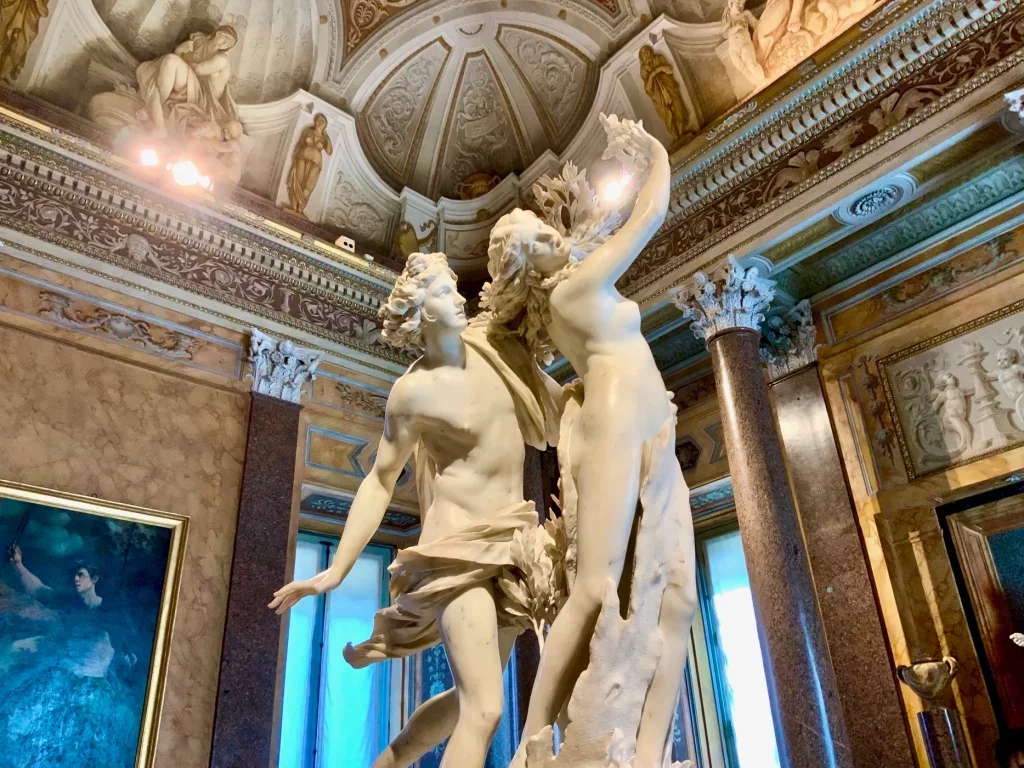
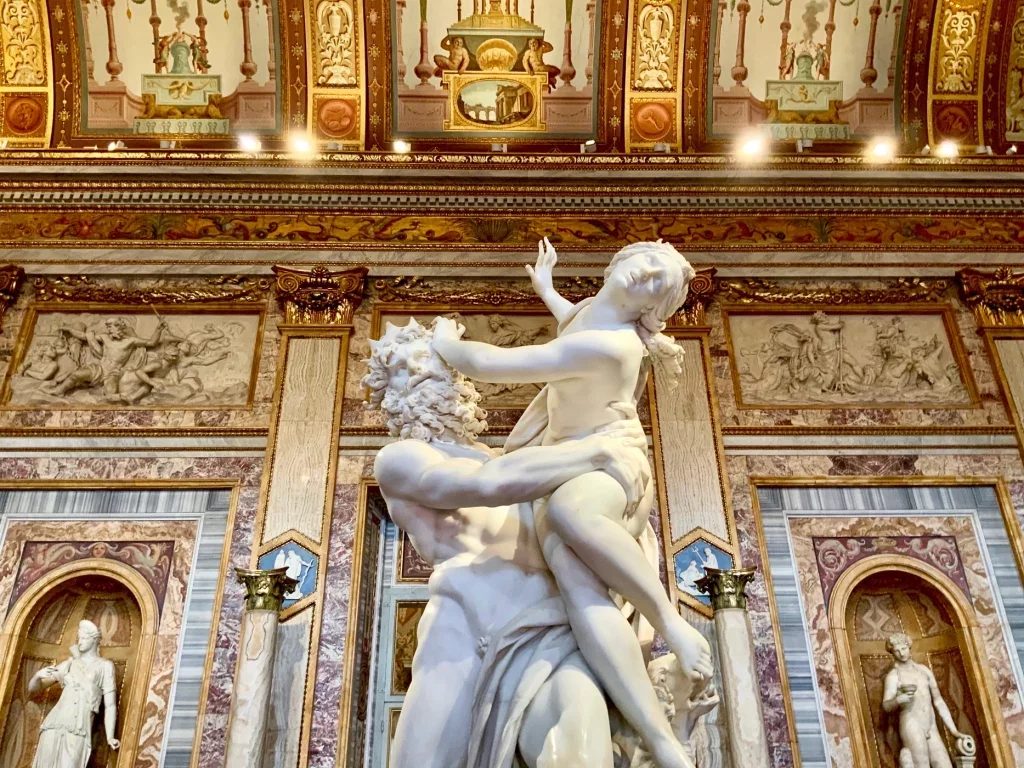
When you’re done admiring the magnificent art, I recommend heading over to the west side of the Borghese Gardens, towards the Piazza del Popolo.
Pop into the Basilica of Santa Maria del Popolo to see two beautiful Caravaggio paintings for free.
The view from the terrace overlooking the Piazza del Popolo is quite beautiful, particularly at sunset.
There are some good restaurants near the Borghese Gallery, if you want to stay in the area for dinner. For gourmet food, try Oliver Glowig (Michelin-starred) or Sapori del Lord Byron. For a cozy informal setting, try Girarrosto Toscano.
2. Vatican City
If you opt for the Vatican City, you’ll be treated to one of the the world’s greatest art collections. Some of the most famous art works on the planet are there.
The highlight of the Vatican Museums is the Sistine Chapel, adorned with Michelangelo frescos. But you also have to visit the Vatican Pinacoteca (painting gallery), the Raphael Rooms, the Pio-Clementine Museum (sculptures), and the Borgia Apartments.
Unless you want to wait in prodigiously long lines, you need to book a skip the line ticket in advance.
If you want to book a skip the line guided tour, you should to be picky about which one you select. Pick a tour tailored to your own interests that includes what you want to see.
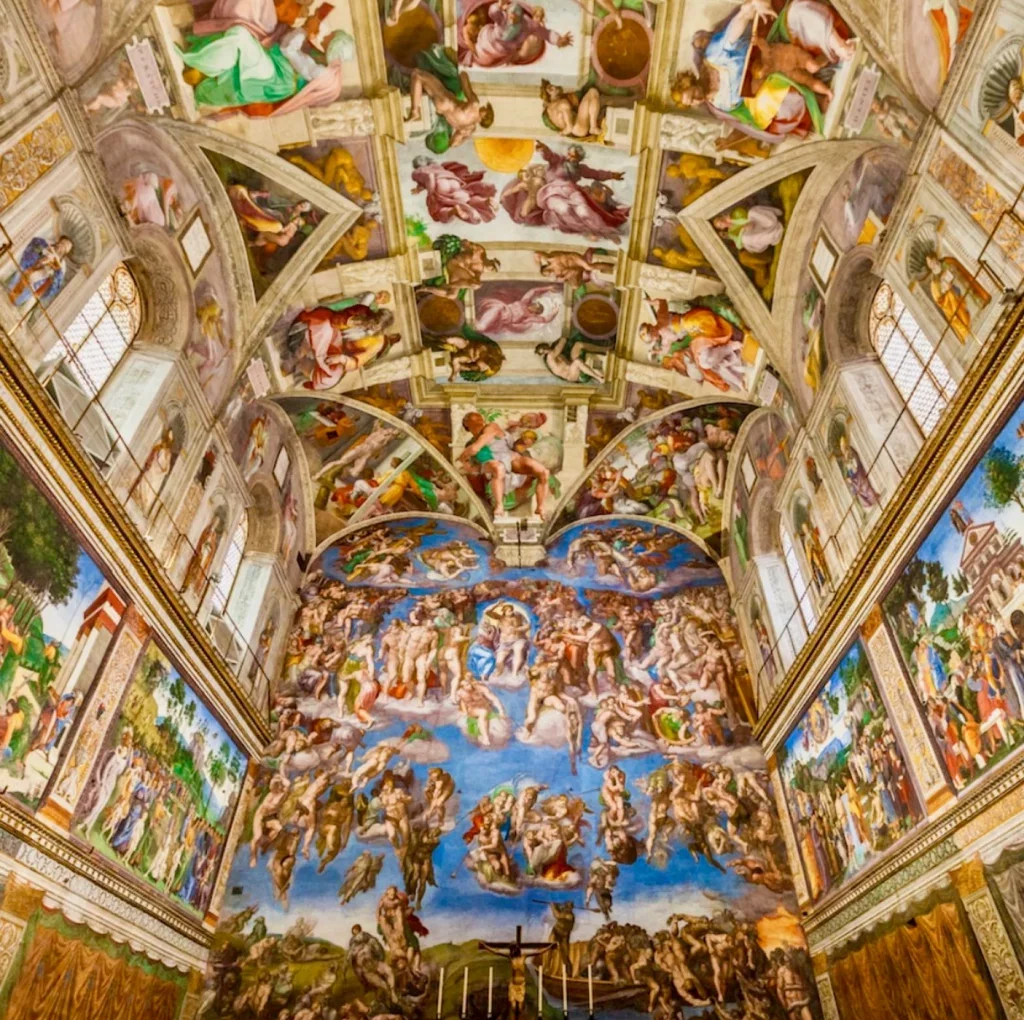
Here are your options:
- 2.5 hour overview on a skip the line small group guided tour
- 3 hour no wait tour that also includes the Raphael Rooms
- 3.5 hour tour Vatican visit with a guided tour of St. Peter’s Basilica
- 3 hour Friday night tour of the Vatican
- Vatican tour that includes a climb of the dome of St. Peter’s Basilica
- 2-3 hour private tour of the Vatican
When you’re done admiring the Vatican treasures, head to St. Peter’s Basilica. This is the most famous church in Christendom. Designed by Bramante, Raphael, and Michelangelo, it’s a true Renaissance masterpiece.
The dome of St. Peters, a Michelangelo tour de force, is the tallest in the world. The basilica is the burial place of St. Peter and past popes.
It houses the famous Bernini Baldachine altar, scads of Bernini sculptures, and Michelangelo’s tragically beautiful Pieta.
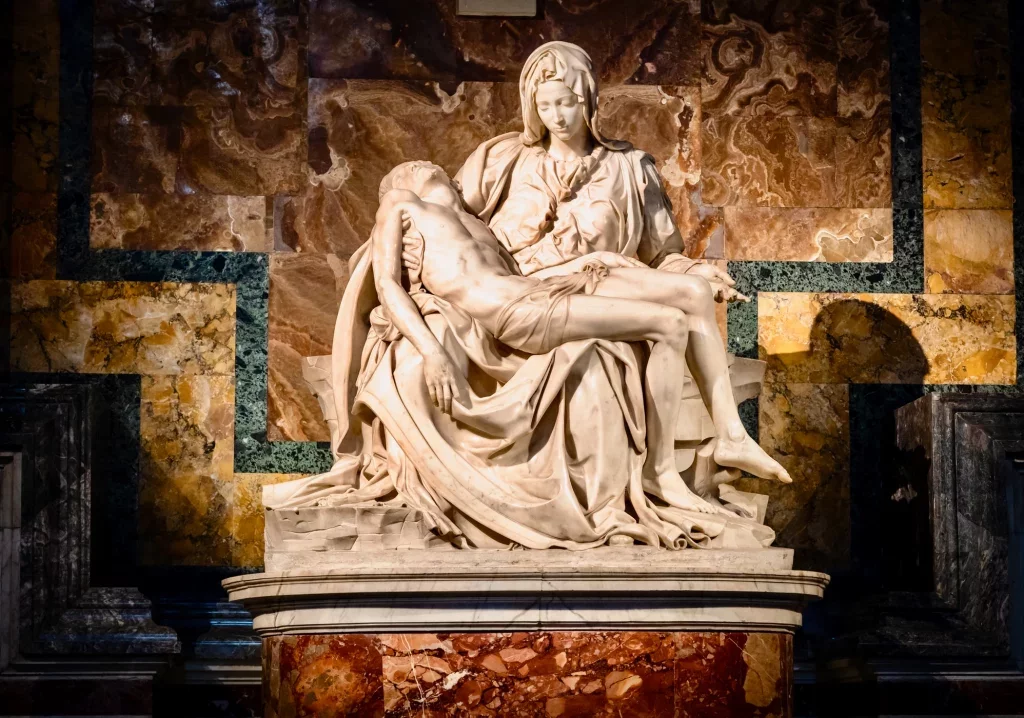
St. Peter’s is free to enter. You can pick up a 1 hour audio guide inside.
But you’ll have to wait in line to go through security. Unfortunately, there is no way to skip the line.
You can climb the dome. A narrow flight of stairs lets you inspect the dome itself at close range.
Continue even higher to stand on the outside of the dome. This is where you have the iconic view of the Bernini-designed St. Peter’s Square and a panoramic view of Rome.
When you’re done Vatican-ing, stop and admire the nearby Castle Sant’Angelo. The castle is a cylindrical beauty at the end of the Sant’Angelo Bridge. It was once Hadrian’s Masoleum. It then served as a fortress, castle, papal residence, and (now) museum.
Then hop in a taxi to Rome’s atmospheric Trastevere neighborhood for the evening.
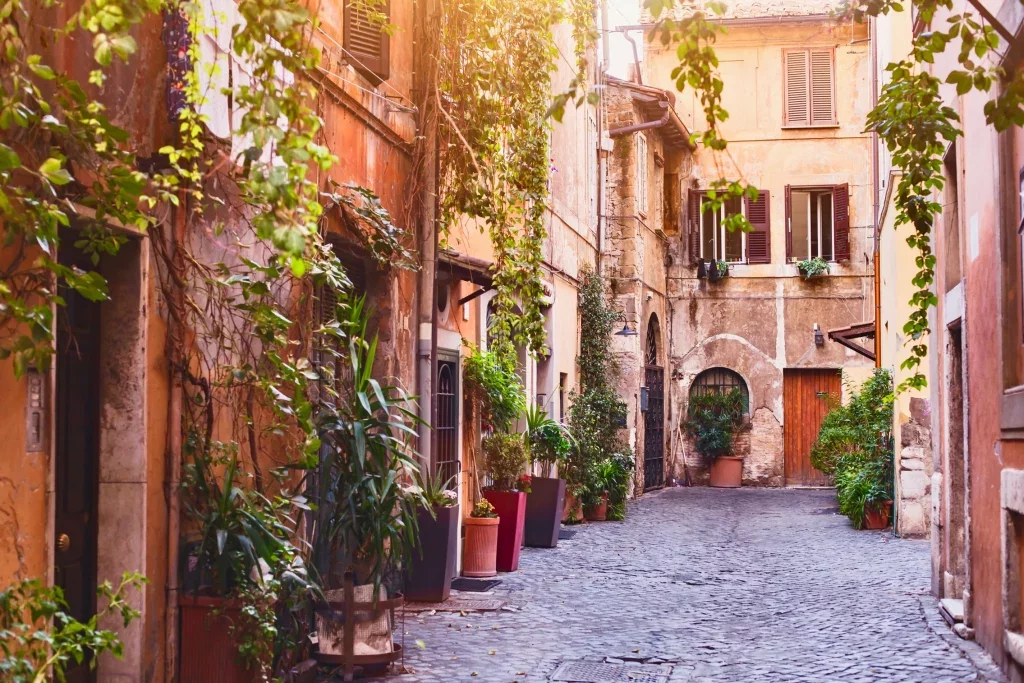
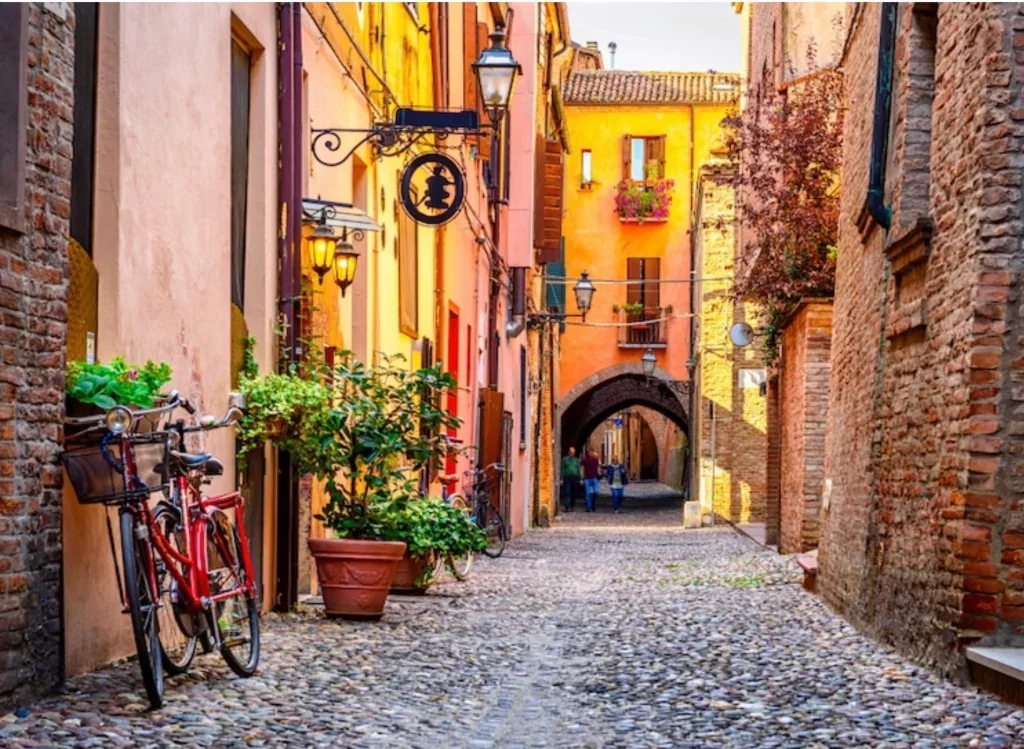
Trastevere is a village within a city, with the laidback vibes of small town Italy. Its lovely cobbled and cafe-lined streets are vastly quieter than the cacophony of central Rome.
Stroll to the lively Piazza di Santa Maria, which is the heart of Trastevere. Head into Santa Maria Basilica, an ancient church decorated with ancient mosaics.
Then, it’s time for happy hour. Settle in for some wine at Enoteca Ferrara in Trastevere, which has a huge wine list. You can eat here too. I had a divine puttanesca.
Otherwise, try Ombre Rosse or La Sora Lella on Isola Tiberna. The latter is one of Rome’s oldest restaurants, serving up classic rustic food in a casual setting. You’ve got to make reservations for both places.
Where To Stay In Rome
One of my personal favorites hotels in Rome is the Rome Cavalieri. The hotel has its own art collection and an art historian will give you a free tour. You will also love the J.K. Place Roma, a simply gorgeous boutique hotel.
If you’re a first timer in Rome, you may want to stay in the historic center around the Pantheon or Piazza Navona. Some good options are the Liberty Boutique Hotel, the Hotel Maalat, Deco Roma, or Hotel Hassler Roma.
If you want to stay near the Imperial ruins, Palazzo Manfredi and the Inn at The Roman Forum are excellent choices. The terrace at the Manfredi is to die for, with breathtaking views. The Inn also has a rooftop terrace and there are even ruins inside the hotel.
If you want to stay in the quieter Monti area, which makes a great base, the Palazzo Manfredi (Colosseum views), Villa Spalletti Trivelli (Roman townhouse), and Roma Luxus (former 18th century palace) are fantastic choices.
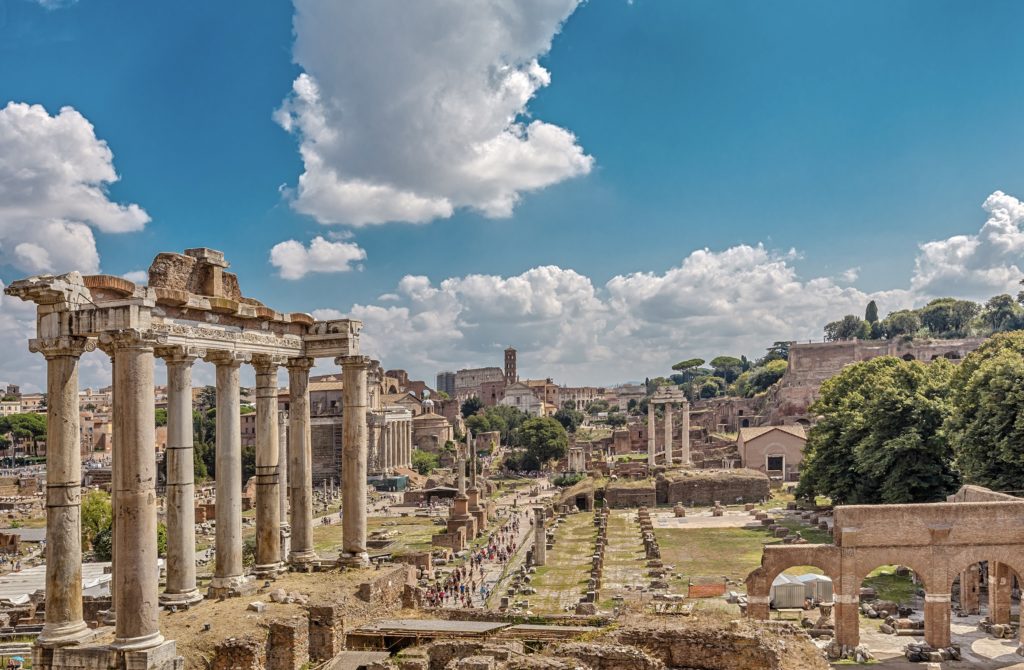
Tips for Driving in Italy
Italy requires you to have an International Driving Permit to drive in Italy. The rental agencies likely won’t ask for it. But if you’re pulled over by the police, you’ll need one.
To get an IDP, head to your local Triple AA office and fill out the required form. For $20, they’ll take your photo and process your permit in less than 30 minutes.
I usually rent from AutoEurope. It will be much cheaper if you know how to drive a manual transmission. But you don’t want to embark on this education in Italy.
You’ll need car insurance, full coverage. The streets in Italy are very narrow and the traffic can be beastly. A tiny ding or dent can really set you back.
When driving, be sure to keep cash on you for the numerous tolls. You’ll have to pay every time you use a motorway based on the distance driven.
You’ll collect a ticket each time you enter a motorway and then pay each time you exit based on the information on your ticket. No credit cards are accepted, so be prepared. Speed cameras are everywhere.
Note that when you rent a car one way in Italy, there’s an added fee because you aren’t dropping the car off at the same location. It’s not a huge deal. The added fee will usually be around $50-$100, depending on how long you stay in Italy.
READ: Complete Guide To Renting a Car and Driving in Europe
I hope you’ve enjoyed my 10 day Italy itinerary for road tripping from Milan to Rome. You may enjoy these other Italy travel guides and resources:
- Historic Landmarks in Italy
- Most Beautiful Towns in Italy
- 101+ Epic Experiences To Have in Italy
- 10 Day Itinerary for Italy’s Major Cities
- 10 Day Itinerary for Tuscany
- 7 Day Road Trip From Venice To Milan
- 2 Day Itinerary for Venice
- Best Museums in Rome
- Hidden Gems in Rome
If you’d like to road trip from Milan to Rome in 10 days, pin it for later.

